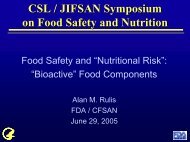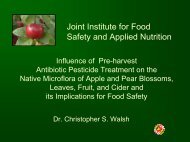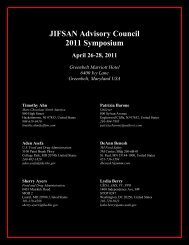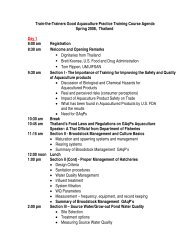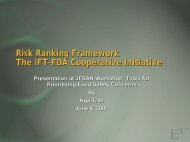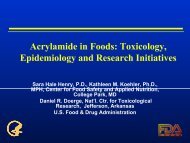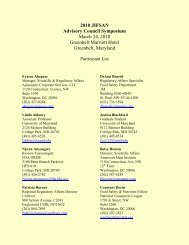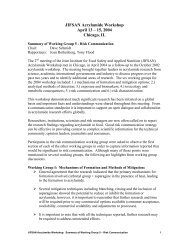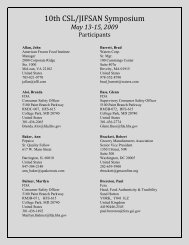drivers for implementation of traceability in the food sector - jifsan
drivers for implementation of traceability in the food sector - jifsan
drivers for implementation of traceability in the food sector - jifsan
You also want an ePaper? Increase the reach of your titles
YUMPU automatically turns print PDFs into web optimized ePapers that Google loves.
N<strong>of</strong>ima - Who are we?Petter OlsenSenior ScientistPetter Olsen, Senior Scientist at N<strong>of</strong>ima, is an expert <strong>in</strong> <strong>food</strong> <strong>traceability</strong>, andrelated electronic data <strong>in</strong>terchange, method development and standardization.K<strong>in</strong>e Mari KarlsenScientistK<strong>in</strong>e Mari Karlsen, Scientist at N<strong>of</strong>ima, implements <strong>traceability</strong> <strong>in</strong> <strong>the</strong> fisheries<strong>sector</strong>.Kathryn Anne-Marie DonnellyScientistKathryn Anne-Marie Donnelly, Scientist at N<strong>of</strong>ima, works on challenges <strong>of</strong><strong>food</strong> <strong>traceability</strong>, standardization and cost/benefit analysis.15 May 2009 c. Kathryn Anne-Marie Donnelly - JIFSAN 2009 3
IntroductionThe ma<strong>in</strong> motivat<strong>in</strong>g factors <strong>for</strong> <strong>traceability</strong> are <strong>food</strong> safety,certification, compliance management, production controlrationalisation, supply cha<strong>in</strong> communication and competitiveadvantage.Experience from <strong>traceability</strong> <strong>implementation</strong> projects such asTRACE provides evidence and <strong>in</strong>sights about <strong>the</strong>se factors andcan give po<strong>in</strong>ters to <strong>the</strong> way <strong>for</strong>wards <strong>for</strong> successful <strong>traceability</strong><strong>implementation</strong>.15 May 2009 c. Kathryn Anne-Marie Donnelly - JIFSAN 2009 4
Motivat<strong>in</strong>g factors <strong>for</strong> <strong>traceability</strong>Modified from Petter Olsens ’cricle diagram’15 May 2009 c. Kathryn Anne-Marie Donnelly - JIFSAN 2009 5
LegislationEurope: Common Food Law 178/2002 - Applies t<strong>of</strong>eed and all <strong>food</strong>stuffsEach Food Bus<strong>in</strong>ess Operator must be able identify all who delivered<strong>food</strong>, feed or <strong>in</strong>gredients that were used <strong>in</strong> production.A mechanism must exist to make this <strong>in</strong><strong>for</strong>mation available to <strong>the</strong>authorities on request.Each Food Bus<strong>in</strong>ess Operator must be able to identify all those <strong>the</strong>ydeliver <strong>food</strong>, feed or <strong>in</strong>gredients to. A mechanism must exist to makethis <strong>in</strong><strong>for</strong>mation available to <strong>the</strong> authorities on request.Food or feed items that will or might be sold <strong>in</strong> <strong>the</strong> EC should belabeled <strong>in</strong> accordance with <strong>sector</strong> specific requirements and <strong>the</strong> codeon <strong>the</strong> label should facilitate identification and enable (targeted) recall.15 May 2009 c. Kathryn Anne-Marie Donnelly - JIFSAN 2009 6
LegislationEurope: Common Food Law 178/2002 - Applies to feed and all<strong>food</strong>stuffsImportant limitationOperators do not have to establish a l<strong>in</strong>k (<strong>in</strong>ternal <strong>traceability</strong>)between <strong>in</strong>com<strong>in</strong>g and outgo<strong>in</strong>g products.There is no requirement <strong>for</strong> records to be kept identify<strong>in</strong>g howbatches are split and comb<strong>in</strong>ed (trans<strong>for</strong>mations)The decision on <strong>the</strong> level <strong>of</strong> detail <strong>of</strong> <strong>the</strong> <strong>in</strong>ternal <strong>traceability</strong>should be left to <strong>the</strong> bus<strong>in</strong>ess operator, commensurate with <strong>the</strong>nature and size <strong>of</strong> <strong>the</strong> <strong>food</strong> bus<strong>in</strong>ess.GUIDANCE ON THE IMPLEMENTATION OF ARTICLES 11, 12, 16, 17, 18, 19 AND 20 OF REGULATION (EC) N° 178/2002 ON GENERAL FOOD LAW CONCLUSIONS OF THE STANDING COMMITTEE ON THE FOOD CHAIN AND ANIMAL HEALTH15 May 2009 c. Kathryn Anne-Marie Donnelly - JIFSAN 2009 7
CertificationSusta<strong>in</strong>abilityOrganicFood milesFair tradeMany <strong>of</strong> <strong>the</strong>ses ’schemes’ require some<strong>for</strong>m <strong>of</strong> documentation <strong>of</strong> product andprocess <strong>in</strong><strong>for</strong>mation.15 May 2009 c. Kathryn Anne-Marie Donnelly - JIFSAN 2009 8
Cha<strong>in</strong> communicationData listsOntologiesStandardisationThese will contribute to improved supply cha<strong>in</strong> managment bymak<strong>in</strong>g it easier and more effective to exchange <strong>in</strong><strong>for</strong>mationelectronically along supply cha<strong>in</strong>s.15 May 2009 c. Kathryn Anne-Marie Donnelly - JIFSAN 2009 9
Cha<strong>in</strong> communication15 May 2009 c. Kathryn Anne-Marie Donnelly - JIFSAN 2009 10
Food safetyTracability enables companies to carry out precision recalls<strong>in</strong> <strong>the</strong> case <strong>of</strong> <strong>food</strong> safety <strong>in</strong>cidentsIn studies carried out both <strong>in</strong> Europe and <strong>in</strong> <strong>the</strong> US <strong>the</strong><strong>traceability</strong> <strong>of</strong> <strong>food</strong> products was tested by carry<strong>in</strong>g outsimulated recallsCompanies unable to answer questions were <strong>of</strong>tensurprised and immediately able to identify <strong>the</strong> use <strong>of</strong><strong>traceability</strong> systems.15 May 2009 c. Kathryn Anne-Marie Donnelly - JIFSAN 2009 11
Food safetyData taken from Donnelly et al (2009) and Lev<strong>in</strong>son (2009)15 May 2009 c. Kathryn Anne-Marie Donnelly - JIFSAN 2009 12
Competitive advantageIt has been shown that many consumers would like more <strong>in</strong><strong>for</strong>mationabout <strong>the</strong> <strong>food</strong> <strong>the</strong>y buy.Traceability can be used to ensure that <strong>the</strong> consumer can get this<strong>in</strong><strong>for</strong>mation.The supermarket ’Co-op’ wants to improve <strong>the</strong> <strong>in</strong><strong>for</strong>mation itsconsumers receive about fresh fish products.It is thought that consumers will prefer products about which <strong>the</strong>y canhave access to product and process <strong>in</strong><strong>for</strong>mation15 May 2009 c. Kathryn Anne-Marie Donnelly - JIFSAN 2009 13
Competitive advantageThere<strong>for</strong>e <strong>the</strong> Co-op wanted to ga<strong>the</strong>r <strong>in</strong><strong>for</strong>mation from fish<strong>in</strong>g boatthrough process<strong>in</strong>g to <strong>the</strong> fresh fish counter at <strong>the</strong> shop, <strong>the</strong>nmake this <strong>in</strong><strong>for</strong>mation available to customers <strong>in</strong> order to ga<strong>in</strong> acompetitive advantage.15 May 2009 c. Kathryn Anne-Marie Donnelly - JIFSAN 2009 14
Labour/Cost reductionExperiences from ’clipfish’ (dried saltedcod) studyCompany was shown to use <strong>in</strong>ternal<strong>traceability</strong> <strong>for</strong> many functions• Controll<strong>in</strong>g quality <strong>of</strong> rawmaterials• Controll<strong>in</strong>g productivity andeffectivety• Stock control15 May 2009 c. Kathryn Anne-Marie Donnelly - JIFSAN 2009 15
Thank you <strong>for</strong> your attention!ReferencesCEN14659 (2003) CEN Workshop Agreement. Traceability <strong>of</strong> Fishery products. Specification <strong>of</strong> <strong>the</strong> <strong>in</strong><strong>for</strong>mation to be recorded <strong>in</strong> caught fish distributioncha<strong>in</strong>s., European Committee <strong>for</strong> Standardization.DONNELLY, K.A-M. and KARLSEN, K.M, Simulated recalls <strong>of</strong> <strong>food</strong> products orig<strong>in</strong>at<strong>in</strong>g <strong>in</strong> <strong>the</strong> European Economic Community In prep.DONNELLY, K. A-M. KARLSEN, K. M., OLSEN, P. & VAN DER ROEST, J. (2008) Creat<strong>in</strong>g Standardized Data Lists <strong>for</strong> Traceability – A Study <strong>of</strong> HoneyProcess<strong>in</strong>g. International Journal <strong>of</strong> Metadata, Semantics and Ontologies, 3, 283-291.DONNELLY, K. A.-M. KARLSEN, K. M. & OLSEN, P. (2009) The importance <strong>of</strong> trans<strong>for</strong>mations <strong>for</strong> <strong>traceability</strong> - A case study <strong>of</strong> lamb and lambproducts. Meat Science, DOI:10.1016/j.meatsci.2009.04.006DONNELLY, K.A.-M. & KARLSEN, K.M. (2009). Challenges and solutions <strong>for</strong> implement<strong>in</strong>g <strong>traceability</strong> <strong>in</strong> <strong>the</strong> dried salted fish <strong>in</strong>dustry. Journal <strong>of</strong>Aquatic Food Product technology SubmittedLEVINSON DR (2009) Traceability <strong>in</strong> <strong>the</strong> Food Supply Cha<strong>in</strong>, Department <strong>of</strong> Health and Human services USA http://oig.hhs.gov15 May 2009 c. Kathryn Anne-Marie Donnelly - JIFSAN 2009 16





